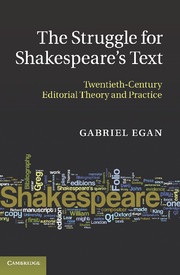Book contents
- Frontmatter
- Contents
- Preface
- Acknowledgements
- A note on references, quotations, names and pronouns
- Introduction
- 1 The fall of pessimism and the rise of New Bibliography, 1902–1942
- 2 New techniques and the Virginian School: New Bibliography 1939–1968
- 3 New Bibliography 1969–1979
- Intermezzo: the rise and fall of the theory of memorial reconstruction
- 4 New Bibliography critiqued and revised, 1980–1990
- 5 The ‘new’ New Bibliography: the Oxford Complete Works, 1978–1989
- 6 Materialism, unediting and version-editing, 1990–1999
- Conclusion: the twenty-first century
- Appendix 1 How early modern books were made: a brief guide
- Appendix 2 Table of Shakespeare editions up to 1623
- Appendix 3 Editorial principles of the major twentieth-century Shakespeare editions
- Works cited
- Index
Appendix 1 - How early modern books were made: a brief guide
Published online by Cambridge University Press: 06 December 2010
- Frontmatter
- Contents
- Preface
- Acknowledgements
- A note on references, quotations, names and pronouns
- Introduction
- 1 The fall of pessimism and the rise of New Bibliography, 1902–1942
- 2 New techniques and the Virginian School: New Bibliography 1939–1968
- 3 New Bibliography 1969–1979
- Intermezzo: the rise and fall of the theory of memorial reconstruction
- 4 New Bibliography critiqued and revised, 1980–1990
- 5 The ‘new’ New Bibliography: the Oxford Complete Works, 1978–1989
- 6 Materialism, unediting and version-editing, 1990–1999
- Conclusion: the twenty-first century
- Appendix 1 How early modern books were made: a brief guide
- Appendix 2 Table of Shakespeare editions up to 1623
- Appendix 3 Editorial principles of the major twentieth-century Shakespeare editions
- Works cited
- Index
Summary
The standard primers on how early modern books were made are R. B. McKerrow's An Introduction to Bibliography for Literary Students (1927) and Philip Gaskell's A New Introduction to Bibliography (1972). The former has significant errors of fact discussed above (pp. 63, 73), which are worth encountering in order to understand how the corrections to McKerrow influenced the debates in the middle of the twentieth century. The latter covers the mechanics of printing well into the twentieth century and only its first half, covering the period of the hand-press, is relevant. For readers who do not wish to pursue these matters in close detail, what follows is the minimum information about early modern printing necessary to follow the narrative of this book. The important details of the manufacture of type and paper are covered by Gaskell but for our purposes these may be left aside and we may start with the early modern compositor standing or sitting in front of two typecases comprising boxes of various sizes containing pieces of type. The typecases are supported on a frame that angles them towards the compositor and stacks one upon another so that the upper case contains the capital letters (still commonly called upper-case letters) and the lower case the small letters. The compositor reads his copy (either handwritten manuscript or an existing book) and one-by-one he selects individual pieces of type representing what he reads and places them into his composing stick, a small hand-held tray set to the width (called the measure) of the page he wishes to print.
- Type
- Chapter
- Information
- The Struggle for Shakespeare's TextTwentieth-Century Editorial Theory and Practice, pp. 231 - 236Publisher: Cambridge University PressPrint publication year: 2010

